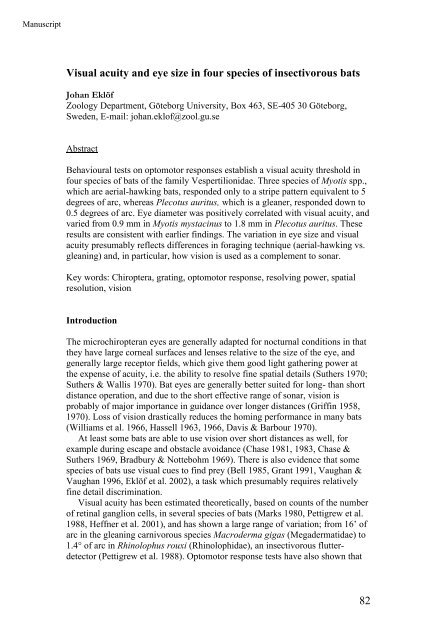Vision in echolocating bats - Fladdermus.net
Vision in echolocating bats - Fladdermus.net
Vision in echolocating bats - Fladdermus.net
You also want an ePaper? Increase the reach of your titles
YUMPU automatically turns print PDFs into web optimized ePapers that Google loves.
Manuscript<br />
Visual acuity and eye size <strong>in</strong> four species of <strong>in</strong>sectivorous <strong>bats</strong><br />
Johan Eklöf<br />
Zoology Department, Göteborg University, Box 463, SE-405 30 Göteborg,<br />
Sweden, E-mail: johan.eklof@zool.gu.se<br />
Abstract<br />
Behavioural tests on optomotor responses establish a visual acuity threshold <strong>in</strong><br />
four species of <strong>bats</strong> of the family Vespertilionidae. Three species of Myotis spp.,<br />
which are aerial-hawk<strong>in</strong>g <strong>bats</strong>, responded only to a stripe pattern equivalent to 5<br />
degrees of arc, whereas Plecotus auritus, which is a gleaner, responded down to<br />
0.5 degrees of arc. Eye diameter was positively correlated with visual acuity, and<br />
varied from 0.9 mm <strong>in</strong> Myotis mystac<strong>in</strong>us to 1.8 mm <strong>in</strong> Plecotus auritus. These<br />
results are consistent with earlier f<strong>in</strong>d<strong>in</strong>gs. The variation <strong>in</strong> eye size and visual<br />
acuity presumably reflects differences <strong>in</strong> forag<strong>in</strong>g technique (aerial-hawk<strong>in</strong>g vs.<br />
glean<strong>in</strong>g) and, <strong>in</strong> particular, how vision is used as a complement to sonar.<br />
Key words: Chiroptera, grat<strong>in</strong>g, optomotor response, resolv<strong>in</strong>g power, spatial<br />
resolution, vision<br />
Introduction<br />
The microchiropteran eyes are generally adapted for nocturnal conditions <strong>in</strong> that<br />
they have large corneal surfaces and lenses relative to the size of the eye, and<br />
generally large receptor fields, which give them good light gather<strong>in</strong>g power at<br />
the expense of acuity, i.e. the ability to resolve f<strong>in</strong>e spatial details (Suthers 1970;<br />
Suthers & Wallis 1970). Bat eyes are generally better suited for long- than short<br />
distance operation, and due to the short effective range of sonar, vision is<br />
probably of major importance <strong>in</strong> guidance over longer distances (Griff<strong>in</strong> 1958,<br />
1970). Loss of vision drastically reduces the hom<strong>in</strong>g performance <strong>in</strong> many <strong>bats</strong><br />
(Williams et al. 1966, Hassell 1963, 1966, Davis & Barbour 1970).<br />
At least some <strong>bats</strong> are able to use vision over short distances as well, for<br />
example dur<strong>in</strong>g escape and obstacle avoidance (Chase 1981, 1983, Chase &<br />
Suthers 1969, Bradbury & Nottebohm 1969). There is also evidence that some<br />
species of <strong>bats</strong> use visual cues to f<strong>in</strong>d prey (Bell 1985, Grant 1991, Vaughan &<br />
Vaughan 1996, Eklöf et al. 2002), a task which presumably requires relatively<br />
f<strong>in</strong>e detail discrim<strong>in</strong>ation.<br />
Visual acuity has been estimated theoretically, based on counts of the number<br />
of ret<strong>in</strong>al ganglion cells, <strong>in</strong> several species of <strong>bats</strong> (Marks 1980, Pettigrew et al.<br />
1988, Heffner et al. 2001), and has shown a large range of variation; from 16’ of<br />
arc <strong>in</strong> the glean<strong>in</strong>g carnivorous species Macroderma gigas (Megadermatidae) to<br />
1.4° of arc <strong>in</strong> Rh<strong>in</strong>olophus rouxi (Rh<strong>in</strong>olophidae), an <strong>in</strong>sectivorous flutterdetector<br />
(Pettigrew et al. 1988). Optomotor response tests have also shown that<br />
82


